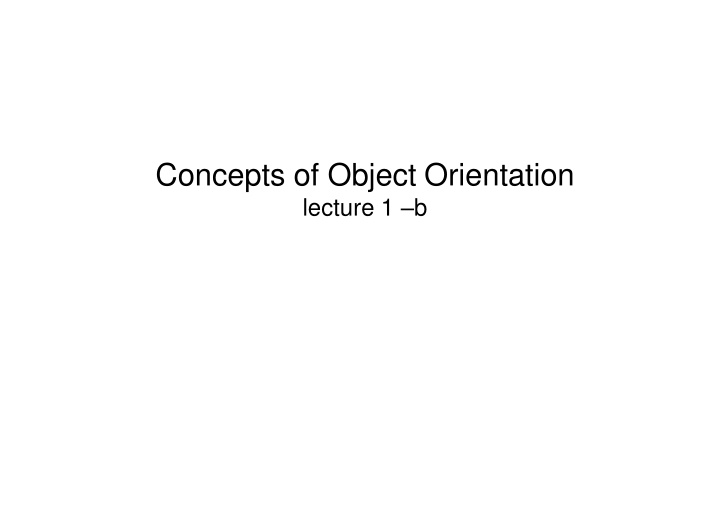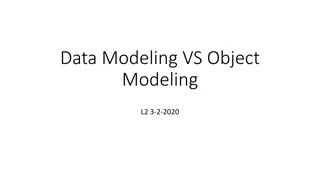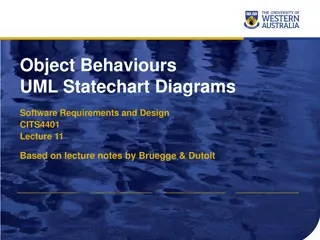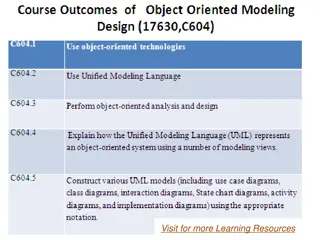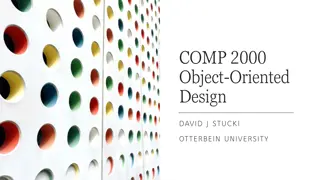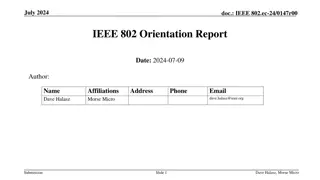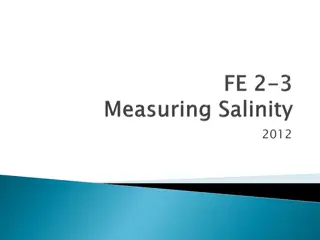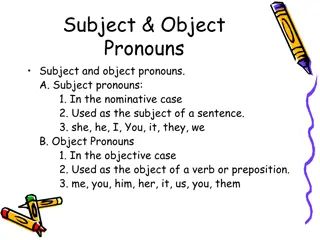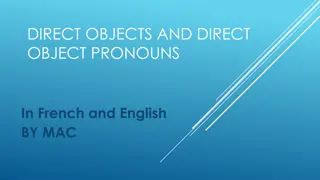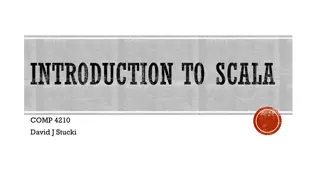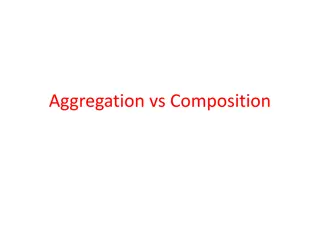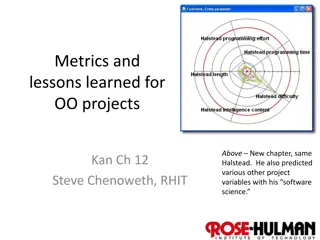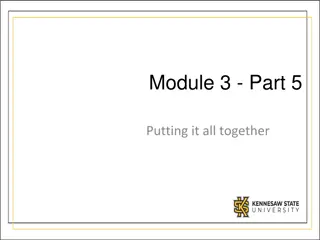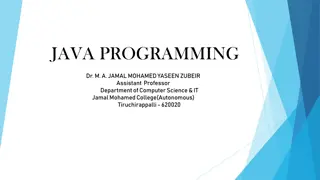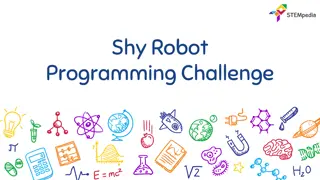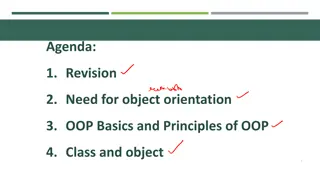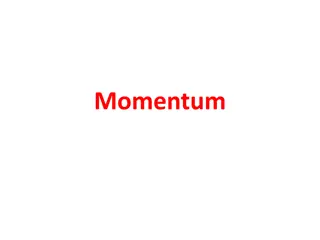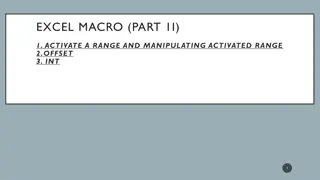Concepts of Object Orientation
This content delves into the fundamental principles and strengths of object orientation, explaining key concepts, terms, and best practices in implementing object technology. It explores the benefits of using object-oriented analysis and design, as well as the importance of modeling and understanding the role of objects in software construction.
Download Presentation

Please find below an Image/Link to download the presentation.
The content on the website is provided AS IS for your information and personal use only. It may not be sold, licensed, or shared on other websites without obtaining consent from the author.If you encounter any issues during the download, it is possible that the publisher has removed the file from their server.
You are allowed to download the files provided on this website for personal or commercial use, subject to the condition that they are used lawfully. All files are the property of their respective owners.
The content on the website is provided AS IS for your information and personal use only. It may not be sold, licensed, or shared on other websites without obtaining consent from the author.
E N D
Presentation Transcript
Concepts of Object Orientation lecture 1 b
Objectives: Concepts of Object Orientation Explain the basic principles of object orientation Define the basic concepts and terms of object orientation Demonstrate the strengths of object orientation OOAD 2
Best Practices Implementation Object technology helps implement these Best Practices. Develop Iteratively: tolerates changing requirements, integrates elements progressively, facilitates reuse. Use Component-Based Architectures: architectural emphasis, component- based development. Model Visually: easy understanding, easy modification. OOAD 3
What Is Object Technology? Object technology A set of principles guiding software construction together with languages, databases, and other tools that support those principles. (Object Technology: A Manager s Guide, Taylor, 1997) OOAD 4
Strengths of ObjectTechnology Provides a single paradigm A single language used by users, analysts, designers, and implementers Facilitates architectural and code reuse Models more closely reflect the real world More accurately describes corporate entities Decomposed based on natural partitioning Easier to understand and maintain Provides stability A small change in requirements does not mean massive changes in the system under development Is adaptive to change OOAD 5
What Is a Model? A model is a simplification of reality. OOAD 6
Why Do We Model? We build models to better understand the system we are developing. Modeling achieves four aims. It: Helps us to visualize a system as we want it to be. Permits us to specify the structure or behavior of a system. Gives us a template that guides us in constructing a system. Documents the decisions we have made. We build models of complex systems because we cannot comprehend such a system in its entirety. OOAD 7
What Is an Object? Informally, an object represents an entity, either physical, conceptual, or software. Physical entity Truck Conceptual entity ChemicalProcess Software entity LinkedList OOAD 8
A More FormalDefinition Attributes An object is an entity with a well-defined boundary and identity that encapsulates state and behavior. State is represented by attributes and relationships. Behavior is represented by operations, methods, and state machines. Object Operations OOAD 9
An Object HasState The state of an object is one of the possible conditions in which the object may exist. The state of an object normally changes over time. Name: J Clark Employee ID: 567138 HireDate:07/25/1991 Status: Tenured Discipline:Finance MaxLoad:3 Name: J Clark Employee ID: 567138 Date Hired: July 25, 1991 Status: Tenured Discipline: Finance Maximum Course Load: 3 classes Professor Clark OOAD 10
An Object Has Behavior Behavior determines how an object acts and reacts. The visible behavior of an object is modeled by the set of messages it can respond to (operations the object can perform). Professor Clark s behavior Submit Final Grades Accept Course Offering Take Sabbatical Maximum Course Load: 3 classes TakeSabbatical() Professor Clark OOAD 11
An Object Has Identity Each object has a unique identity, even if the state is identical to that of another object. Professor J Clark teaches Biology Professor J Clark teaches Biology OOAD 12
Representing Objects in theUML An object is represented as a rectangle with an underlined name. J Clark : Professor Named Object : Professor Professor J Clark Unnamed Object OOAD 13
Basic Principles of Object Orientation ObjectOrientation Encapsulation Modularity Abstraction Hierarchy OOAD 14
What IsAbstraction? The essential characteristics of an entity that distinguish it from all other kinds of entities Defines a boundary relative to the perspective of the viewer Is not a concrete manifestation, denotes the ideal essence of something OOAD 15
Example: Abstraction Student Professor Course Offering (9:00 AM, Monday-Wednesday-Friday) Course (e.g.,Algebra) OOAD 16
What Is Encapsulation? Hide implementation from clients. Clients depend on interface. Improves Resiliency OOAD 17
EncapsulationIllustrated Professor Clark needs to be able to teach four classes in the next semester. Professor Clark Name: J Clark Employee ID: 567138 HireDate: 07/25/1991 Status:Tenured Discipline:Finance SetMaxLoad(4) MaxLoad:4 TakeSabbatical() OOAD 18
What Is Modularity? Modularity is the breaking up of something complex into manageable pieces. Modularity helps people to understand complex systems. OOAD 19
Example:Modularity For example, break complex systems into smaller modules. Billing System Course Catalog System Course Registration System Student Management System OOAD 20
What Is Hierarchy? Asset Increasing abstraction BankAccount Security RealEstate Savings Checking Stock Bond Elements at the same level of the hierarchy should be at the same level of abstraction. Decreasing abstraction OOAD 21
What Is a Class? A class is a description of a set of objects that share the same attributes, operations, relationships, and semantics. An object is an instance of a class. A class is an abstraction in that it Emphasizes relevant characteristics. Suppresses other characteristics. Class + attribute + operation() OOAD 22
Representing Classes in theUML A class is represented using a rectangle with compartments. Professor - name - employeeID : UniqueID - hireDate - status - discipline - maxLoad + submitFinalGrade() + acceptCourseOffering() + setMaxLoad() + takeSabbatical() Professor J Clark OOAD 23
The Relationship Between Classes and Objects A class is an abstract definition of an object. It defines the structure and behavior of each object in the class. It serves as a template for creating objects. Classes are not collections of objects. Professor ProfessorTorpie ProfessorMeijer ProfessorAllen OOAD 24
What Is an Attribute? An attribute is a named property of a class that describes a range of values that instances of the property may hold. A class may have any number of attributes or no attributes atall. Student - name - address - studentID - dateOfBirth Attributes OOAD 25
What Is an Operation? An operation is the implementation of a service that can be requested from any object of the class to affect behavior. A class may have any number of operations or none at all. Student + getTuition() + addSchedule() + getSchedule() + deleteSchedule() + hasPrerequisites() Operations OOAD 26
What Is Polymorphism? The ability to hide many different implementations behind a single interface Manufacturer B Manufacturer C ManufacturerA OO Principle: Encapsulation OOAD 27
Example:Polymorphism shapeArea.getCurrentValue() Square Circle Triangle OOAD 28
